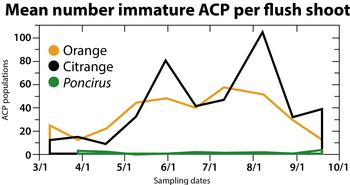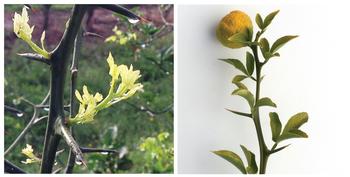HLB control: capitalizing on resistance in Poncirus trifoliata to Asian citrus psyllid

Article written by David Hall, Elizabeth Grafton-Cardwell, Peggy G. Lemaux, & Lukasz Stelinski.
Revised December 12, 2017.
What is the technique?
All Citrus species are susceptible to colonization by large numbers of the Asian citrus psyllid (ACP). In contrast, Poncirus trifoliata is a genotype with strong resistance to ACP infestations. Poncirus and Citrus are closely related and readily hybridized. Research is therefore being conducted to identify traits responsible for ACP resistance in Poncirus and to determine if these traits can be passed to hybrids with Citrus species or utilized in other ways to reduce ACP infestation and HLB in citrus.
How does it improve HLB management?
Current recommendations to growers confronted with HLB are to plant disease-free nursery stock, routinely identify and remove infected trees to reduce inoculum loads, and aggressively manage populations of the psyllid. Insecticidal control is the key tactic used to manage the psyllid, but host plant resistance holds some promises or clues in the search for alternative tactics. Field, laboratory and greenhouse investigations have confirmed that ACP infestations are greatly reduced on Poncirus. One trait involved has already been identified: Poncirus leaves emit volatiles that discourage oviposition. The specific volatiles involved are being investigated. There may be other chemical traits that work in concert with these volatiles to reduce ACP colonization of Poncirus. If the chemicals that deter ACP infestations can be identified, they might be applied directly to reduce infestations in citrus. Further, the genes responsible for producing these chemicals in Poncirus might be transferred to citrus through conventional breeding.
Who is working on the project?
David Hall, Steve Lapointe and Ed Stover have led research efforts to develop management tactics for ACP based on resistant traits associated with Poncirus. They are with USDA’s Agricultural Research Service, U.S. Horticultural Research Laboratory located in Fort Pierce, FL.
What are the challenges and opportunities?

Funding source: This project is funded by the Citrus Research & Development Foundation.


